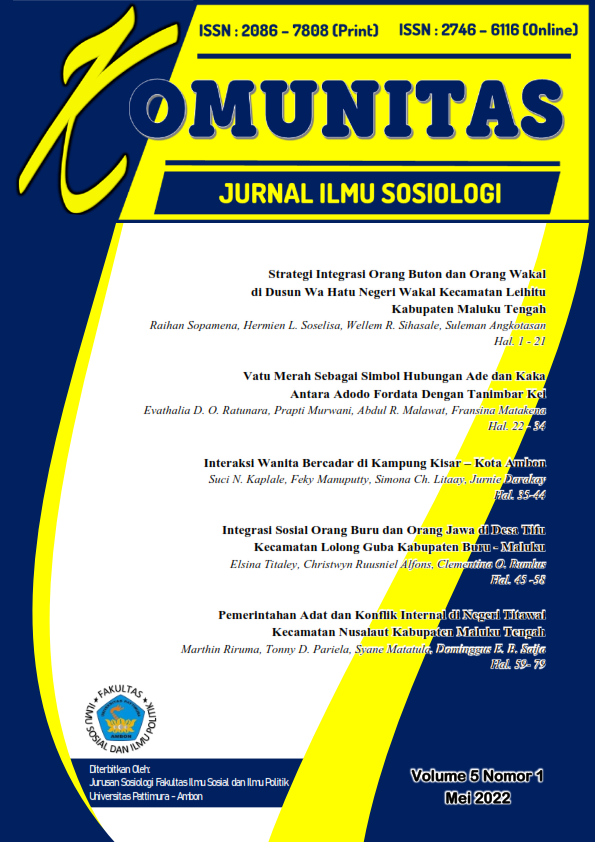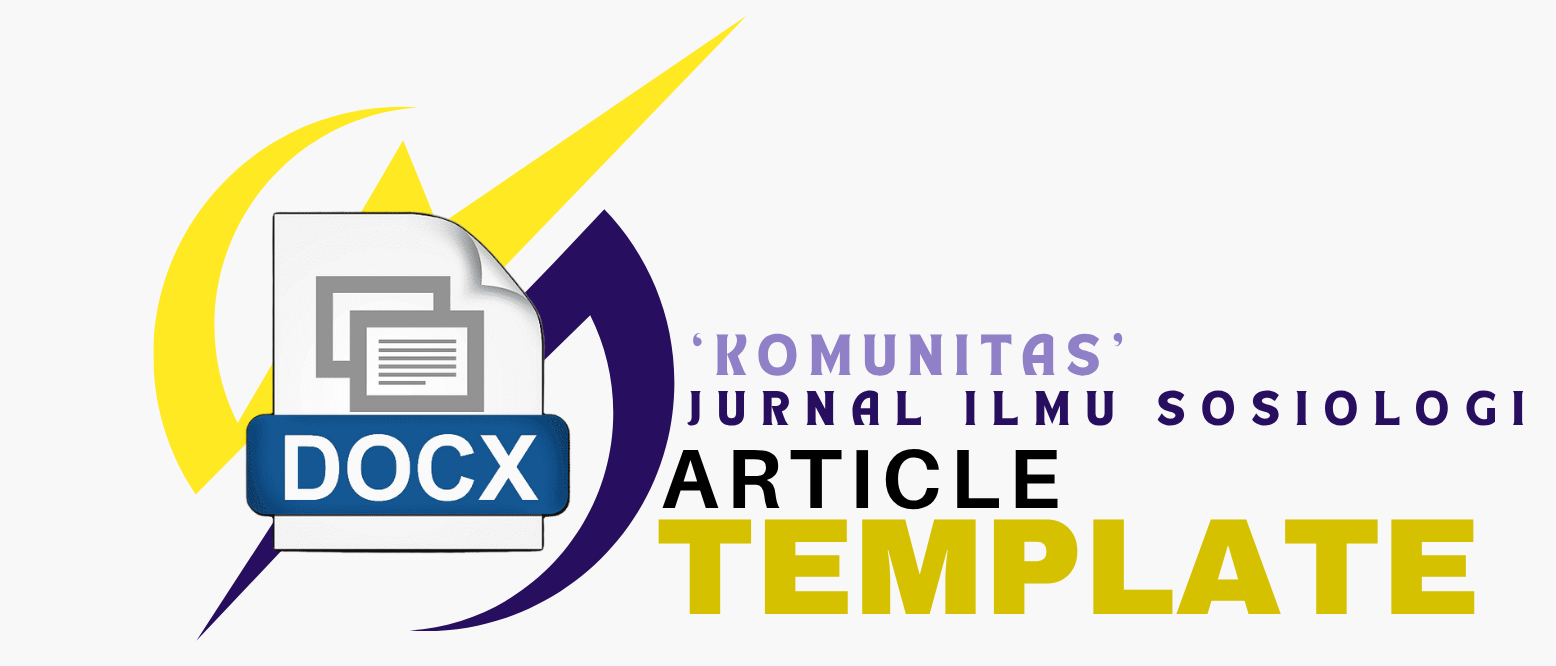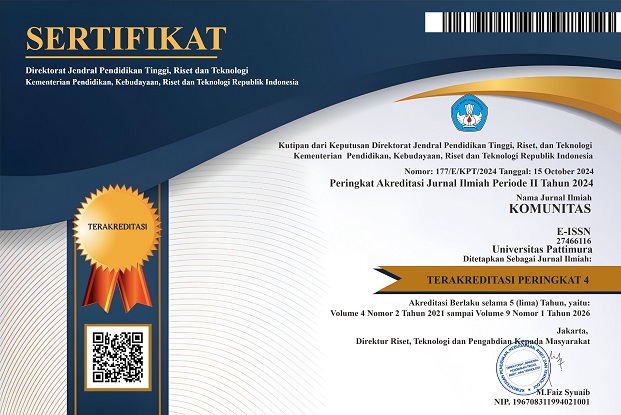VATU MERAH SEBAGAI SATU SIMBOL HUBUNGAN ADE DAN KAKA ANTARA ADODO FORDATA DENGAN TANIMBAR KEI
Abstract
Pada masa sekarang ini banyak pergeresan budaya dan kultur dari masyarakat akibat perkembangan sains dan teknologi. Vatu Mera merupakan sebuah prastasi budaya antara Desa Adodo Fordata dengan Tanimbar Kei. Prastasi budaya ini sebagai simbol ikatan ade dan kaka yang tidak terpisahkan dan dalam kesatuan yang utuh. Tujuan dari penelitian ini adalah untuk mengetahui bagaimana interaksi sebelum dan sesudah didirikannya prasasti Vatu Merah. Hasil penelitian membuktikan bahwa dengan adanya partisipasi Vatu Mera sangat baik di tengah masyarakat dalam menjaga dan melestarikan hubungan persaudaran yang rukun dengan hidup teratur dan menghagai atar dua etnis yang berbeda. Prasasti Vatu Mera dianggap sangat penting bagi hubungan mereka yang sudah ada sejak lama. Pandangan masyarakat terhadap prasasti Vatu Merah merupakan sebuah bukti sejarah bagi generasi muda yang akan datang, agar mereka tahu bahwa mereka memiliki ikatan ade-kaka antara Tanimbar Kei dengan Desa Adodo Fordata.
Downloads
References
Adluri, S. (2019). Viewing Telugu Inscriptions at Ahobila. South Asian Studies, 35(2), 168–180. https://doi.org/10.1080/02666030.2019.1641968
Ashida, S., Robinson, E. L., Williams, K., Hejna, E. E., & Thompson, L. E. (2020). Social Interactions between Family and Community-Based Service Providers in Dementia Caregiving. Clinical Gerontologist, 00(00), 1–12. https://doi.org/10.1080/07317115.2020.1765932
Aureli, F., & Schino, G. (2019). Social complexity from within: how individuals experience the structure and organization of their groups. Behavioral Ecology and Sociobiology, 73(1). https://doi.org/10.1007/s00265-018-2604-5
Bernstein, M. J., Zawadzki, M. J., Juth, V., Benfield, J. A., & Smyth, J. M. (2018). Social interactions in daily life: Within-person associations between momentary social experiences and psychological and physical health indicators. Journal of Social and Personal Relationships, 35(3), 372–394. https://doi.org/10.1177/0265407517691366
Bui, H. T., & Wilkins, H. C. (2016). Current Issues in Tourism Social interactions among Asian backpackers : scale development and validation. 3500(August). https://doi.org/10.1080/13683500.2016.1205553
Chua, A. (2002). The influence of social interaction on knowledge creation. Journal of Intellectual Capital, 3(4), 375–392. https://doi.org/10.1108/14691930210448297
Ellen, R. (2019). Pottery production and trade in the Banda zone, Indonesia: The Kei tradition in its spatial and historical context. Indonesia and the Malay World, 47(138), 133–159. https://doi.org/10.1080/13639811.2019.1582862
Gallelli, A. (2016). Social Structure and Cultural Production: An Empirical Analysis of Festivals’ Networks. Journal of Arts Management Law and Society, 46(1), 34–46. https://doi.org/10.1080/10632921.2015.1131217
Gasteyer, S., & Araj, T. (2009). Empowering Palestinian Community Water Management Capacity: Understanding the Intersection of Community Cultural, Political, Social, and Natural Capitals. Community Development, 40(2), 199–219. https://doi.org/10.1080/15575330903012288
Griffiths, A. (2021). The sanskrit inscription of śankara and its interpretation in the national history of Indonesia. Bijdragen Tot de Taal-, Land- En Volkenkunde, 177(1), 1–26. https://doi.org/10.1163/22134379-bja10014
Hallmann, K., Rossi, L., Breuer, C., & Ilgner, M. (2020). Determinants of public perception of elite sport. International Journal of Sport Policy and Politics, 12(3), 439–453. https://doi.org/10.1080/19406940.2020.1794930
Idang, G. E. (2018). African Culture and Values. Phronimon, 16(2), 97–111. https://doi.org/10.25159/2413-3086/3820
Jaysawal, N. (2013). Civil society, Democratic space, And social work. SAGE Open, 3(4). https://doi.org/10.1177/2158244013504934
Kuo, M.-M., & Lai, C.-C. (2006). Linguistics across Cultures: The Impact of Culture on Second Language Learning. Online Submission, 1(1), 1–10.
Li, Y. Q., & Liu, C. H. (2019). The power of coworkers in service innovation: the moderating role of social interaction. International Journal of Human Resource Management, 30(12), 1956–1976. https://doi.org/10.1080/09585192.2017.1314310
Litt, E., Zhao, S., Kraut, R., & Burke, M. (2020). What Are Meaningful Social Interactions in Today’s Media Landscape? A Cross-Cultural Survey. Social Media and Society, 6(3). https://doi.org/10.1177/2056305120942888
Lyvers, M., Hanigan, C., & Thorberg, F. A. (2018). Social Interaction Anxiety, Alexithymia, and Drinking Motives in Australian University Students. Journal of Psychoactive Drugs, 50(5), 402–410. https://doi.org/10.1080/02791072.2018.1517228
Mansyur, S. (2005). Permukiman Tradisional Masyarakat Tanimbarkei. Kapata Arkeologi, Vol. 1(No. 1, Agustus), 70–87. https://doi.org/http://dx.doi.org/10.24832/kapata.v1i1.17
Nadler, J. (2017). Expressive Law, Social Norms, and Social Groups. Law and Social Inquiry, 42(1), 60–75. https://doi.org/10.1111/lsi.12279
O’Connell, B. H., O’Shea, D., & Gallagher, S. (2016). Enhancing social relationships through positive psychology activities: a randomised controlled trial. Journal of Positive Psychology, 11(2), 149–162. https://doi.org/10.1080/17439760.2015.1037860
Qiong, O. U. (2017). A Brief Introduction to Perception. Studies in Literature and Language, 15(4), 18–28. https://doi.org/10.3968/10055
Rajapaksa, D., Islam, M., & Managi, S. (2018). Pro-environmental behavior: The role of public perception in infrastructure and the social factors for sustainable development. Sustainability (Switzerland), 10(4). https://doi.org/10.3390/su10040937
Singh, T. B. (2012). A social interactions perspective on trust and its determinants. Journal of Trust Research, 2(2), 107–135. https://doi.org/10.1080/21515581.2012.708496
Stapleton, S. R. (2015). Environmental identity development through social interactions, action, and recognition. Journal of Environmental Education, 46(2), 94–113. https://doi.org/10.1080/00958964.2014.1000813
Yamin, P., Fei, M., Lahlou, S., & Levy, S. (2019). Using social norms to change behavior and increase sustainability in the real world: A systematic review of the literature. Sustainability (Switzerland), 11(20). https://doi.org/10.3390/su11205847


2.png)










.png)

